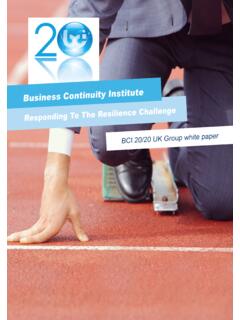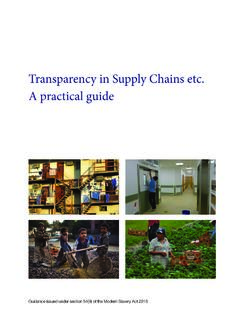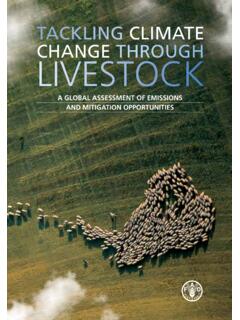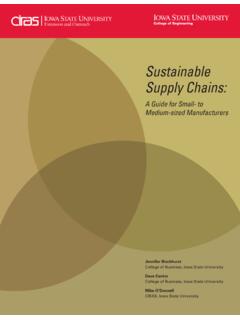Transcription of Supply Chain Resilience Report 2021
1 Find out more Chain Resilience Report 2021 Contents3 Foreword5 Executive Summary12 Overview14 Levels of Reporting and Technology Uptake21 Frequency and Origin of Supply Chain Disruption26 Causes and Consequences of Supply Chain Disruption40 Insurance45 Business Continuity Arrangements and Due Diligence66 Annex2 Supply Chain Resilience Report 2021 Find out more to the 12th edition of the BCI s Supply Chain Resilience Report . This Report comes after a year where many organizations have seen their Supply chains disrupted and tested more than ever before. COVID-19 first entered most organizations radars at the beginning of 2020, and Supply chains were quickly affected.
2 Factory shutdowns in the Far East were the cause of early disruptions and, as the virus quickly became global , disruption became more widespread: logistics channels required rapid remodelling, suppliers became unable to meet contract terms and manufacturing plants closed due to component Continuity s role in helping to avoid and mitigate disruption has come to the forefront this year. Encouragingly, more organizations than ever before are now recording, measuring and reporting on performance-affecting Supply Chain disruptions via an enterprise-wide, coordinated approach. There has been a significant increase in the number of organizations using technology: for the first time, more than half of organizations are now using technology to help streamline the recording and analytics COVID-19 will have been partially responsible for increasing the use of technology in the monitoring and reporting process, the area where it has had most impact is in Supply Chain mapping.
3 With key suppliers unable to meet contract requirements and other organizations discovering backup suppliers sourced from tier 2 suppliers, the need to fully understand supplier networks has been highlighted. With laws and regulations being introduced to encourage and enforce ethical Supply Chain practices, the need to implement best practice in Supply Chain mapping is now of paramount severe Supply Chain disruptions and their concurrent knock-on effects to organizations balance sheets has resulted in Management taking a much greater interest in Supply Chain Resilience , something which continuity, risk and Resilience professionals have been wanting for many years.
4 83% of professionals Report that management commitment to Supply Chain risk is now medium or high and some are already seeing funds diverted to Business Continuity for investment in additional staff and/or technology. While positives can be taken from 2020, there is still work to be done before Supply Chain disruptions become more manageable. As an example, just 1 in 6 organizations carry out due diligence on key suppliers at the procurement stage, with a quarter leaving it until contracts are signed. Many organizations are still failing to carry out appropriate levels of due diligence on their suppliers, particularly those beyond their immediate , 2020 has been a force for change, and the positive increases we have noted this year in terms of the depth of due diligence, mapping processes and closer relationships with suppliers will mean organizations are better positioned to deal with future global disruptions.
5 We just have to ensure the lessons learnt are not are delighted to have the support of Everstream in producing this year s Supply Chain Resilience Report , particularly given how the use of technology for managing Supply chains is moving from a nice to have to a must have . We hope that this year s findings are useful and allow you to benchmark your organization s processes and procedures against your peers and further enhance your organization s Supply Chain Horne FBCI Chair of the BCIF oreword3 ForewordEverstream Analytics is honoured to have partnered with the Business Continuity Institute on this Report ; perhaps the most timely and important Supply Chain Resilience Report to say that lessons can and must be learned from our combined experiences in 2020 is likely an understatement.
6 But because of the unprecedented nature of the Covid-19 pandemic it is important to ensure that we learn the right Report draws from a depth of data and in person interviews that will allow readers to more fully understand how the pandemic impacted global Supply chains, how different companies reacted and the lasting changes that will be with us for years to come. It also analyzes other ways in which Supply chains were disrupted and how the impact of these events was compounded by the of the lasting changes from 2020 will be a rethinking of how companies must address Supply Chain risk. Underpinned by new technologies, risk analytics will be embedded in Supply Chain decision making and will become a competitive advantage for those companies that can be more agile as well as more resilient than their competition.
7 This shift presents a significant opportunity for business continuity professionals to protect and create value across the enterprise by partnering with their colleagues in Supply Chain remarkable speed with which vaccines have been brought to market will help bring the pandemic under control but other risks are on the rise. Major weather events are growing in severity and frequency and longer-term challenges from climate change will require a holistic, end-to-end, dynamic and predictive approach to managing Supply Chain risk. Our acquisition of Riskpulse in 2019 is a response to our clients need to better predict the impact of weather and climate on their Supply Chain networks and we continue to invest in technology that helps companies discover unknown sub-tier suppliers and hidden but no means least we acknowledge the daily work of the front-line workers who have kept food and medicine moving through global Supply chains and who now carry hope-restoring vaccines across the globe.
8 As we say at Everstream Analytics, this Report will help you to Get In Front of What s Shillingford CEO Everstream Analytics 4 Supply Chain Resilience Report 2021 Find out more Chain Resilience Executive Summary5 Executive Summary More organizations than ever are now using technology to assist with Supply Chain management and mapping: More than half ( ) of organizations are now using technology to help analyse and Report on Supply Chain disruptions, with the number using technology to help with Supply Chain mapping seeing a major increase to (2019: ). More than half of organizations ( ) Report that COVID-19 has been the reason for investment in new technology and tools.
9 The number of Supply Chain disruptions organizations encountered in 2020 was higher than any other year in the Report s history: of organizations reported more than 20 Supply Chain disruptions during 2020, up from just reporting the same number in 2019. Organizations blamed COVID-19 for the dramatic increase in the volume of disruptions, although European respondents reported disruptions due to Brexit-related disruptions were more likely to occur beyond tier 1: The importance of knowing your suppliers suppliers was emphasised this year when respondents reported that of COVID-related disruptions were due to disruptions in tier 2 and beyond.
10 Although this year s research shows that organizations due diligence beyond tier 1 is improving, COVID-19 has served as a tool to uncover where the gaps in processes lie. Solving the logistics puzzle has been a key challenge to organizations during 2020 and is set to continue into 2021: All methods of transportation have been affected because of COVID-19. At the start of the pandemic, air freight providers repurposed passenger planes to make up for the lack of belly cargo availability, land transport had its own challenges with goods being held up at borders and sea freight is now struggling with global container shortages.








